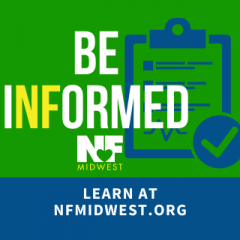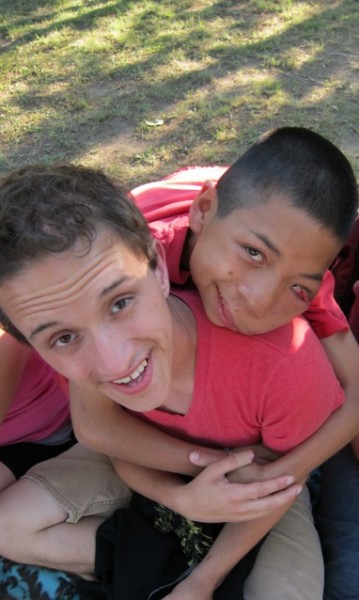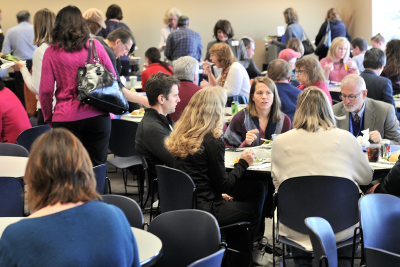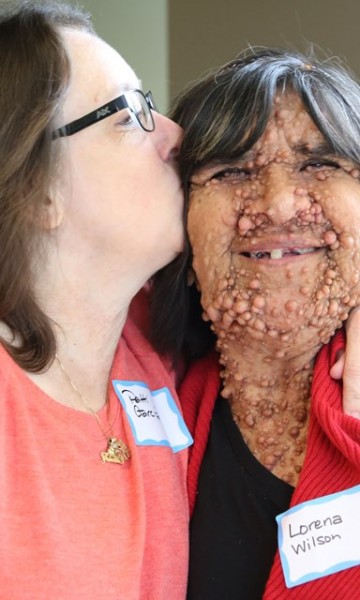
Pain in Neurofibromatosis Type 1
Pain in NF1
One of most common challenges for individuals with NF1 is living with chronic pain. By definition, chronic pain is persistent pain that continues for weeks, months, or even years. This occurs when the pain signals within a person’s nerves continue to fire, and the severity can vary by individual. In general, it is estimated that about 25% of the general U.S. population ages 20 and over report pain lasting greater than 24 hours. In patients with NF1, estimates of those experiencing chronic pain range from 35 to 53%.
Common Causes of Pain in NF1
What are some of the NF1-related symptoms and conditions that cause pain? Probably the most common of these is plexiform neurofibromas, or PNs. PNs are benign tumors comprised of a proliferation of cells in the nerves. They are found in about 30 to 50% of people with NF1. Most often, they grow rapidly during childhood, although they may go for years without being detected.
Up to half of people with NF1 may experience recurrent headaches that are severe enough to interfere with their daily lives. These headaches can begin during childhood, and are typically described as migraines or tension headaches. An occasional cause of headaches in adolescents and adults with NF1 is an adrenal tumor called a pheochromocytoma. This is an endocrine tumor that causes an excess of catecholamine.
About one fourth of people with NF1 develop scoliosis or other orthopedic problems. Scoliosis often is treated with surgery and corrective braces, both of which can be quite painful and can negatively impact a person’s quality of life. Another orthopedic condition that occurs in a small number of people with NF1 is called pseudarthrosis, a problem that can lead to pain and fractures of the long bones that don’t heal.. Other causes of spinal pain in NF1 are spinal tumors, dural ectasia and vertebral damage resulting from osteopenia.
Glomus tumors are noncancerous tumors that appear on fingers and toes. They are rare compared to PNs, but cause extreme pain when they occur. Gastrointestinal complications in the NF1 population can be caused by neurofibromas in the stomach and are sometimes called abdominal migraines. These are also uncommon in NF1, but when they occur they can lead to severe pain.
Given the many pain-related symptoms and complications in individuals with NF1, it is important to let your doctor know about any pain you have. It is ideal to work with a physician who was expertise in NF1. If your doctor does not have experience with this disease, it may be worthwhile to seek out someone who does.
Impact of Pain on Daily Life
The conditions and symptoms described above emphasize the major challenges faced by people with NF1. Not surprisingly, researchers have found that more severe symptoms, including pain, are associated with diminished quality of life among adults and children with NF1. Further, more severe pain has been found among children who have more symptoms of depression and anxiety. According to questionnaires completed by parents of children with NF1, the children with worse pain have a harder time keeping up with activities of daily living, such as dressing, grooming, and getting along with peers. These research findings seem to suggest that pain has a negative impact on things like emotional functioning and quality of life. However, the relationship seems to work both ways. That is, many people report that their pain feels worse when they feel sad, when the quality of their relationships is poor, or even when they have an overall decrease in life satisfaction.
Treatment for Pain
A) Medical
Many researchers are developing and investigating drugs that they hope will prevent tumor growth and ultimately shrink the size of PNs. But right now, the main treatment is surgical removal of the tumors. Because these tumors grow along the nerves, surgery can be complicated and may be avoided altogether if the risk to loss of function is too great. Also, many times the tumors (and associated pain) return after surgery.
NF1-related symptoms sometimes can be managed with pain medication, including nonsteroidal anti-inflammatory drugs (NSAIDs, such as ibuprofen), anticonvulsants (such as Neurontin), and narcotics (such as morphine and oxycodone). But these options are not perfect. Many people taking these medications experience side effects, such as loss in appetite, constipation, nausea, rash, mood or sleep disturbances. Moreover, the medications do not always get rid of pain completely. In fact, researchers have noted that children with NF1 taking pain medication rated their pain higher than those not on pain medications. In our own experience with patients who come to the NIH, we frequently meet people who complain of pain despite taking pain medication. Moreover, these individuals often have been experiencing pain for a number of years and have considerable difficulty coping with their pain.
B) Psychological Treatments
So far, no research about psychological methods for managing pain in NF1 has been published. However, techniques that have been found to be helpful in people with other chronic pain conditions may offer some guidance.
There are several types of stress management techniques that can be helpful for people with pain due to a variety of conditions. Progressive muscle relaxation and guided imagery have been used with some success in patients with cancer, osteoarthritis, and recurrent abdominal symptoms. Another option, mindfulness-based treatments, teaches individuals to focus on present moment sensations with an attitude of acceptance and without judgment. These techniques are becoming increasingly popular, as a growing body of research supports their effectiveness with chronic pain patients.
Cognitive-behavioral therapy (CBT) involves trying to change the way a person thinks about his or her pain, realizing how those thoughts impact behavior, and then gradually working towards a return to normal functioning. A related technique, Acceptance and Commitment Therapy (ACT), focuses on helping patients live a full, satisfying life doing the things they value the most in spite of their pain. Another technique that is often effective is biofeedback, which involves teaching a person to regulate their bodily responses to pain, such as muscle tension, heart rate, and brain waves. Many of these techniques are paid for by insurance, although coverage varies widely. Some companies may be more likely to help with the cost if the technique is part of a comprehensive psychological treatment plan rather than a specific pain coping technique in isolation.
C) Physical Activity
Yoga has been found helpful among adults with arthritis, low back pain, and other conditions. Its benefits include a reduction in pain severity and an increase in one’s ability to accomplish their day-to-day tasks. Given that many individuals with NF1 are limited in their ability to play sports or do aerobic exercise; this may provide a suitable alternative. More vigorous physical activity can reduce pain in various disorders, but exercise programs should always be tailored to the individual’s functional abilities and discussed with physicians before starting.
Any of the above techniques should be done in consultation with an appropriate health professional, such as a physician or psychologist. No treatment works well for everyone, but many people with chronic pain benefit from finding the medical and/or psychological treatment that is right for them. Also, it is very important to inform your doctor immediately of any new pain or if your pain increases, especially if the pain emanates from a known PN since new or worsening pain could indicate tumor growth or a malignancy. In addition, tell your doctor if you have any change in your ability to accomplish normal activities of daily living. Even though doctors do not have all the answers, it is important for patients to work with their physicians as a team and to be actively engaged in their own care.
References
Burns, K. M., Wolters, P. L., Martin, S., Baldwin, A., Dombi, E., Kurwa, A., Gillespie, A., Salzer, W., and Widemann, B. (2011). Parent and self reports of pain in children and adolescents with NF1 and plexiform neurofibromas: relation to quality of life, social-emotional functioning, and physical manifestations. Poster presented at the National Conference in Pediatric Psychology, San Antonio, TX.
Heuschkel, R., Kim, S., Korf, B., Schneider, G., & Bousvaros, A. (2001). Abdominal migraine in children with neurofibromatosis type 1: a case series and review of gastrointestinal involvement in NF1. Journal of Pediatric Gastroenterology and Nutrition, 33(2), 149-154.
Jett, K., & Friedman, J. M. (2010). Clinical and genetic aspects of neurofibromatosis 1.Genetics in Medicine, 12(1), 1-11.
Korf, B. R., Schneider, G., & Poussaint, T. Y. (1999). Structural anomalies revealed by neuroimaging studies in the brains of patients with neurofibromatosis type 1 and large deletions. Genetics in Medicine, 1(4), 136-140.
Page, P. Z., Page, G. P., Ecosse, E., Korf, B. R., Leplege, A., & Wolkenstein, P. (2006). Impact of neurofibromatosis 1 on Quality of Life: A cross-sectional study of 176 American cases. American Journal of Medical Genetics Part A, 140A(18), 1893-1898.
Tonsgard, J. H. (2006). Clinical manifestations and management of neurofibromatosis type 1. Seminars in Pediatric Neurology, 13, 2-7.
Kim, A., Gillespie, A., Dombi, E., Goodwin, A., Goodspeed, W., Fox, E., Balis, F., and Widemann, B. (2009). Characteristics of children enrolled in treatment trials for NF1-related plexiform neurofibromas. Neurology, 73(16), 1273-1279.







.png)





